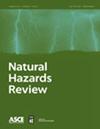灾难中的家庭流离失所和回归:综述
IF 1.8
3区 工程技术
Q3 ENGINEERING, CIVIL
引用次数: 0
摘要
:灾后家庭流离失所已成为全球许多地区的普遍现象,2008 年至 2018 年间,至少有 2.65 亿人受到影响。虽然这一数字包括短期和可能挽救生命的撤离,但有大量证据表明,并非所有家庭都能在紧急阶段后返回家园。长期流离失所会给受影响家庭和社区带来特别不利的后果。然而,关于流离失所持续时间的现有数据十分有限,而且只有少数灾后恢复模型包含了除住房损坏以外的众多已知会影响家庭返回的因素。本研究综述了当前有关灾害引发的流离失所的文献,包括关键术语和背景、家庭回归决策的决定因素、现有的基于模型的方法以及未来研究的机遇。已确定的家庭返回的关键决定因素可大致分为以下几类:建筑环境的物理损坏、心理和社会现象(如对地方的依恋、社会网络)、家庭人口统计(如保有权、社会经济地位)以及灾前和灾后政策(如住房重建方法、援助项目的设计)。DOI: 10.1061/NHREFO.NHENG-1930.本作品采用知识共享署名 4.0 国际许可协议的条款进行发布,https://creativecommons.org/licenses/by/4.0/。本文章由计算机程序翻译,如有差异,请以英文原文为准。
Household Displacement and Return in Disasters: A Review
: Household displacement following disasters has become endemic in many areas worldwide, affecting at least 265 million people between 2008 and 2018. Although this figure includes short-term and potentially life-saving evacuations, there is ample evidence that not all households return after the emergency phase. Protracted displacement is associated with particularly negative consequences for the affected households and community. Yet, existing data on displacement duration are limited, and only a few disaster recovery models incorporate the multitude of factors beyond housing damage that are known to influence household return. This review synthesizes the current literature on disaster-induced displacement, including key terminology and context, the determinants of household return decisions, existing model-based approaches, and opportunities for future research. The identified key determinants of household return can be broadly organized into the following categories: physical damage to the built environment, psychological and social phenomena (e.g., attachment to place, social networks), household demographics (e.g., tenure, socioeconomic status), and pre-and postdisaster policies (e.g., housing reconstruction approach, design of aid programs). DOI: 10.1061/NHREFO.NHENG-1930. This work is made available under the terms of the Creative Commons Attribution 4.0 International license, https://creativecommons.org/licenses/by/4.0/.
求助全文
通过发布文献求助,成功后即可免费获取论文全文。
去求助
来源期刊

Natural Hazards Review
ENGINEERING, CIVIL-GEOSCIENCES, MULTIDISCIPLINARY
CiteScore
4.90
自引率
7.40%
发文量
72
审稿时长
3 months
期刊介绍:
The Natural Hazards Review addresses the range of events, processes, and consequences that occur when natural hazards interact with the physical, social, economic, and engineered dimensions of communities and the people who live, work, and play in them. As these conditions interact and change, the impact on human communities increases in size, scale, and scope. Such interactions necessarily need to be analyzed from an interdisciplinary perspective that includes both social and technical measures. For decision makers, the risk presents the challenge of managing known hazards, but unknown consequences in time of occurrence, scale of impact, and level of disruption in actual communities with limited resources. The journal is dedicated to bringing together the physical, social, and behavioral sciences; engineering; and the regulatory and policy environments to provide a forum for cutting edge, holistic, and cross-disciplinary approaches to anticipating risk, loss, and cost reduction from natural hazards. The journal welcomes rigorous research on the intersection between social and technical systems that advances concepts of resilience within lifeline and infrastructure systems and the organizations that manage them for all hazards. It offers a professional forum for researchers and practitioners working together to publish the results of truly interdisciplinary and partnered approaches to the anticipation of risk, loss reduction, and community resilience. Engineering topics covered include the characterization of hazard forces and the planning, design, construction, maintenance, performance, and use of structures in the physical environment. Social and behavioral sciences topics include analysis of the impact of hazards on communities and the organizations that seek to mitigate and manage response to hazards.
 求助内容:
求助内容: 应助结果提醒方式:
应助结果提醒方式:


